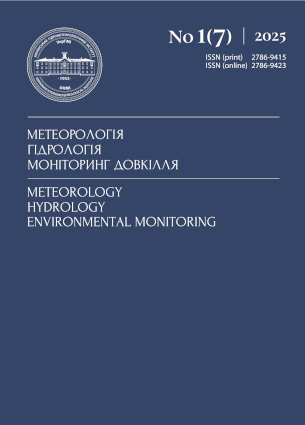SOLVING HYDROGEOLOGICAL PROBLEMS IN THE CONTEXT OF ASSESSING RESOURCE LOSSES AND THE FEASIBILITY OF RESTORATION OF THE KAKHOVKA RESERVOIR
Ukrainian Hydrometeorological Institute of the State Emergency Service of Ukraine and the National Academy of Sciences of Ukraine
https://orcid.org/0000-0002-5791-5354
Ivan Tverdyi
South Ukrainian Hydrogeological Expedition SE Ukrainian Geological Company, Kherson
https://orcid.org/
Andrii Oreshchenko
Ukrainian Hydrometeorological Institute of the State Emergency Service of Ukraine and the National Academy of Sciences of Ukraine
https://orcid.org/0000-0002-8363-6885
Abstract
References
1. Baer, R.A., Gryza, A.A., Lyutaev, B.V., & Smirnov, R.A. (1978). Engineering and hydrogeological basis for amelioration construction. Kyiv: Budivelnyk, 200 p.
2. Chornomorets, Y.O., Perevozchykov, I.M., Oreshchenko, A.V., & Mala, L.M. (2023). Determination of flow characteristics of the lower Dnipro taking into account the demolition of the Kakhovka HPP dam. Meteorology. Hydrology. Environmental Monitoring, 2(4), 51-61. https://doi.org/10.15407/Meteorology2023.04.075">https://doi.org/10.15407/Meteorology2023.04.075
3. Dai, A. (2013). Increasing drought under global warming in observations and models. Nat. Climate Change, 3, 52–58, https://doi.org/10.1038/nclimate1633.
4. Danylyshyn, B.M., Dorohuntsov, S.I., Mishchenko, V.S., et al. (1999). Natural resource potential for sustainable development of Ukraine. Ed. B.M. Danylyshyn, Kyiv.
5. Detailed geological and economic assessment of operational reserves of drinking groundwater of the Berislavska-2 section of the Berislavsky deposit using wells No. 2-183, 2-281 of the water intake of PJSC Berislavsky Machine-Building Plant in the city of Berislav, Kherson region. (2017). Report on exploration of the groundwater deposit section (with reserve estimates as of 01.10.2017). Lyzohub V.O. et al., Kherson.
6. Detailed geological and economic assessment of operational reserves of drinking groundwater of the water intake of PJSC “Novokakhovsky processed cheese factory” within the “Okrema” section of the Novokakhovsky deposit in the city of Tavriysk, Kherson region. (2016). Tverda O.V., Lyzohub V.O., Kherson.
7. Detailed geological and economic assessment of operational reserves of drinking groundwater of the Khersonska-2 section of the Kherson deposit in wells No. 20-212, 20-446 of the water intake of PrJSC 'Dnepr Terminal' in Kherson (as of November 1, 2015). (2015). Lyzohub V.O., Gorban O.M. et al., Kherson.
8. Eskov, B.G. (1970). Engineering and geological features of the upper Dnieper alluvium. Kyiv: Scientific opinion.
9. Falkenmark, Malin and J. Rockstrom. (2004). Balancing water for humans and nature. The new approach in ecohydrology. London: Sterling, VA.
10. Gurievskikh, L.S. (2015). Information report on groundwater monitoring in the territory of Kherson and Mykolaiv regions as of 01.01.2016. Kherson. Prychornomor SEGE, Prychornomor SEGE Funds.
11. Kamzist, Z.S., & Shevchenko, O.L. (2009). Hydrogeology of Ukraine. Textbook. Kyiv.
12. Kanivets, V.V., Derkach, G.А. (2024). Overview of the results of research of radioactive contamination of the Kakhovka reservoir, which were conducted after the accident at the Chernobyl NPP (1986-2021). Meteorology. Hydrology. Environmental Monitoring, 2(4), 27-38.
13. Lyalko, V.I. (1965). On the Formation of the Groundwater Balance in the Dnieper-Molochnaya Interfluve. Coll. articles “Water Management”, Issue 1. Kyiv.
14. Methodological recommendations for assessing the impact of reservoirs on groundwater resources and reserves. (1973). Moscow: VSEGINGEO Publishing House.
15. Methods of studying and assessing deep groundwater resources. (1986). Ed. Bondarenko S.S., Vartanyan G.S., Moscow.
16. Moklyak, V.I. (1962). Evaporation losses from the water surface. In the book. Hydrological calculations for rivers of Ukraine. Kyiv. 187-206.
17. Report on detailed exploration of underground water for water supply in Novaya Kakhovka of the Kherson region of the Ukrainian SSR (calculation of operational reserves as of August 1, 1973). (1973). L.G. Pashchenko, Odessa.
18. Smirnov, R.A., Bogdanov, V.I., Gryza, A.A., & Soldak, A.G. (1973). Hydrogeological surveys in built-up areas. Kyiv.
19. Shevchenko A.L. (1993). Effect of irrigation with Dnieper water on the distribution of strontium-90 and cesium-137 in natural components. Irrigation melioration - its development, efficiency and problems. Proc. int. sci. conf. Kherson, VI-1993, Kherson, NIIOS UAAS, 141-142.
20. Shevchenko, O.L. (2023). Modern water conflicts and confrontations (hydrogeological aspect). Meteorology, Hydrology, Environmental Monitoring, 2(4), 75-86. https://doi.org/10.15407/Meteorology2023.04.075">https://doi.org/10.15407/Meteorology2023.04.075
21. Shevchenko, O.L., Dolin, V.V., & Shabatura, O.V. (2021). Hydrogeology of mineral deposits: textbook. Kyiv: VPC 'Kyiv University'.
22. Shevchenko, O.L., & Khrushchov, D.P. (2021). Theoretical and applied principles of prudent use of groundwater. Infogeophrams in hydrogeology. Bulletin of Taras Shevchenko National University of Kyiv (Geology), 3(94), 109-120. http://doi.org/10.17721/1728-2713.94.14
23. Shevchenko, O.L., Kondratyuk, E.I., & Charny, D.V. (2022). Autonomous groundwater supply systems as a necessary safeguard against humanitarian disasters under military aggression. Geological Journal, 3, 3-17. https://doi.org/10.30836/igs.1025-6814.2022.3.255733
24. Shevchenko, O., Osadchiy, V., Charnyi, D.V., Onanko, Y.A., Grebin, V.V. (2019). Influence of global warming on the groundwater resources of the Southern Bug River basin 18th International Conference «Geoinformatics: Theoretical and Applied Aspects», Geoinformatics 2019 (Kyiv; 13-16 May 2019), art. no. 15890. Conference Paper Cite Score 2019; Kyiv, Ukraine.
25. Shevchenko, A.L., Skorbun, A.D., & Charny, D.V. (2021). Subordination of groundwater level fluctuations in the Southern Bug river basin to climate change. Bulletin of Odesa National University. Series: Geographical and Geological Sciences, 26, 2(39), 175-194.
26. Shiklomanov, I.A. (1989). Influence of economic activity on river flow. Leningrad: Gidrometeoizdat.
27. The experience and methodology of studying hydrogeological and engineering-geological conditions of large reservoirs. (1959). Ed. Zolotarev G.S., Sokolov D.S., Chapovsky E.G. Moscow University Publishing House. Part 1.
28. Tvedt, T. (2013). Journey to the future of water. Kyiv: Nika-Center.
29. Van Lanen, H.A.J., Laaha, G., Kingston, D.G., Gauster, T., Ionita, M. et al. (2016). Hydrology needed to manage droughts: the 2015 European case. Hydrological Processes, 30 (17), pp.3097-3104. ff10.1002/hyp.10838ff. ffhal-01528779
30. Voropaev, G.V., Blagoverov, B.G., & Ismailov, G.Kh. (1986). Economic and geographical aspects of the formation of territorial units in water management. Moscow: 'Nauka'.
31. Vyshnevskyі, V.I. (2011). Dnipro River. Kyiv.
32. Vyshnevskyi, V.І. & Shevchuk, S.А. (2024). Natural Processes in the Area of the Former Kakhovske Reservoir After the Destruction of the Kakhovka HPP. Journal of Landscape Ecology, 17(2), 2024. 147-164. https://doi.org/10.2478/jlecol-2024-0014
33. Water exchange in hydrogeological structures of Ukraine. Water exchange in disturbed conditions. (1991). Ed. V.M. Shestopalov, E.A. Yakovlev, et al. Kyiv: Naukova Dumka.
34. Zhernov, I.E. (1982). Dynamics of groundwater. Kyiv.

